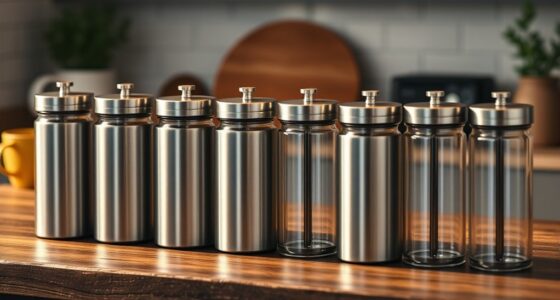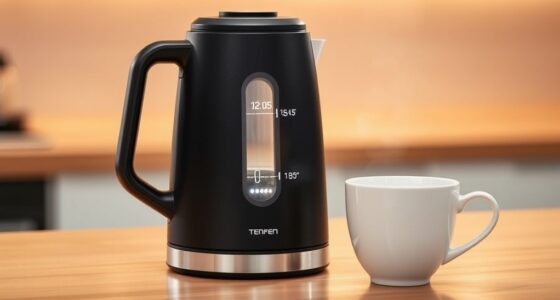Understanding mattress materials helps you choose the right one for your sleep needs. Innerspring mattresses have steel coils that offer support and good airflow but may sag over time. Memory foam molds closely to your body, providing pressure relief but can trap heat. Latex mattresses are resilient, responsive, and eco-friendly, lasting longer. If you want a detailed comparison of these materials and their features, keep exploring to find what fits you best.
Key Takeaways
- Memory foam contours to the body, offers excellent pressure relief, and reduces motion transfer, but tends to trap heat.
- Latex is highly responsive, resilient, durable, and naturally breathable, providing a supportive and cooling sleep surface.
- Innerspring mattresses use steel coil cores for support, promote airflow, and are generally more budget-friendly but may have higher motion transfer.
- Memory foam lasts 10-20 years, latex 15-20 years, while innerspring support declines faster, typically within 7-10 years.
- Natural latex is eco-friendly, hypoallergenic, and sustainably harvested, making it suitable for allergy sufferers and environmentally conscious buyers.
Innerspring Mattress Construction and Benefits
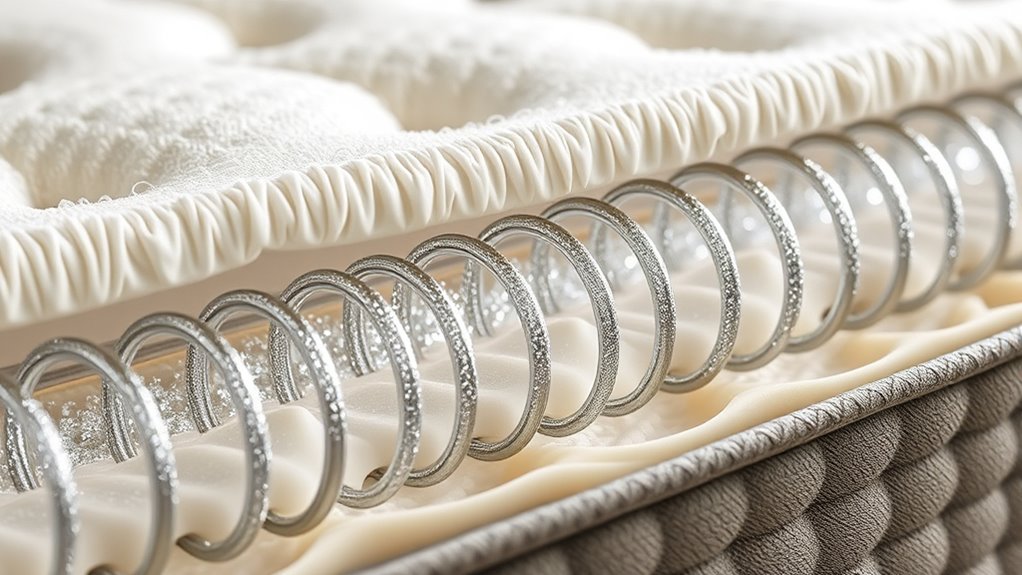
Innerspring mattresses are built around a core of steel coil springs that provide essential support and responsiveness. These steel coils vary in gauge and design, such as pocketed coils, which offer targeted coil support and reduce motion transfer. The mattress construction often includes foam padding or additional layers for pressure relief and comfort. Reinforced edges improve edge support, allowing you to sleep near the perimeter without sagging. The open coil structure promotes airflow, helping dissipate heat and keep your sleep surface cooler. The airflow facilitated by the open coil design helps regulate temperature and enhances sleep quality. Additionally, the steel coils’ ability to resist sagging contributes to the mattress’s overall durability, making it a long-lasting investment. The open coil design also improves air circulation, which plays a significant role in maintaining a comfortable sleeping environment. Proper coil design and construction also help prevent coil squeaking, enhancing overall comfort during sleep. Durability is a key benefit, as steel coils withstand years of use. Plus, you can choose from different firmness levels to match your preferences. Overall, the combination of coil support, mattress construction, and airflow makes innerspring mattresses a reliable, supportive choice.
Memory Foam Composition and Comfort Features
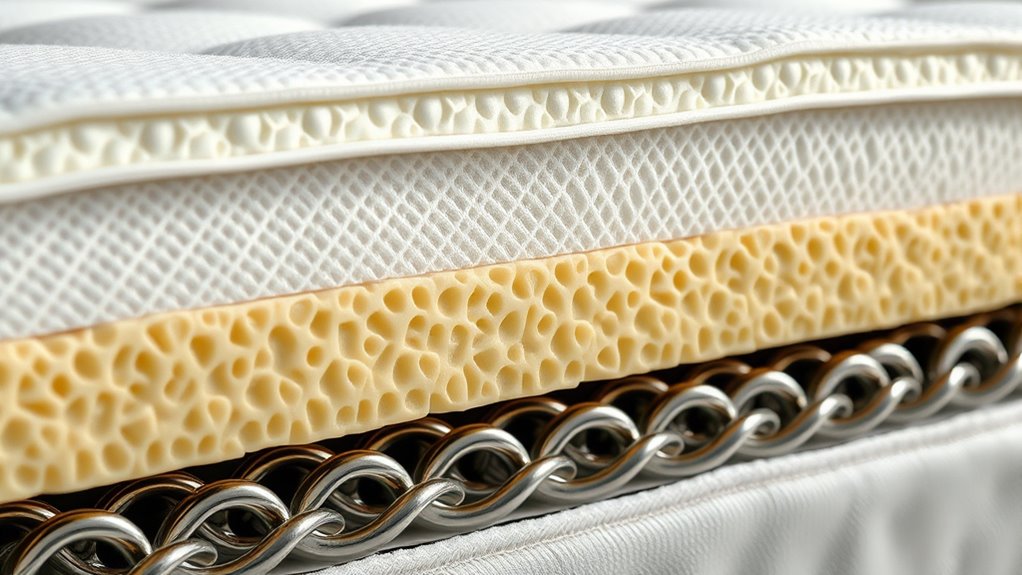
Memory foam is made from viscoelastic polyurethane, which softens when exposed to heat and pressure, allowing it to mold closely to your body’s shape. This material offers excellent pressure relief by evenly distributing your weight and reducing stress on joints and pressure points. Its slow response time creates a sinking, contouring feel that enhances comfort features. Memory foam‘s ability to conform to your body contours makes it an effective support system, helping you feel supported and relaxed. Additionally, heat retention can be a concern, as the material tends to trap warmth, potentially leading to warmer sleeping conditions. Many memory foam mattresses incorporate foam layers with cooling gels or other temperature regulation technologies to improve airflow and maintain a comfortable sleep environment, balancing comfort with supportive benefits. Proper regular maintenance and cleaning can help preserve the mattress’s comfort and hygiene over time. To mitigate issues like heat buildup, some memory foam mattresses now include ventilation channels designed to enhance airflow and keep the sleeping surface cooler. Furthermore, incorporating breathable fabrics in mattress covers can also aid in regulating temperature and improving overall sleep comfort. Additionally, selecting a mattress with adaptive cooling technology can further enhance sleep quality during warmer nights.
Latex Mattress Types and Eco-Friendly Options
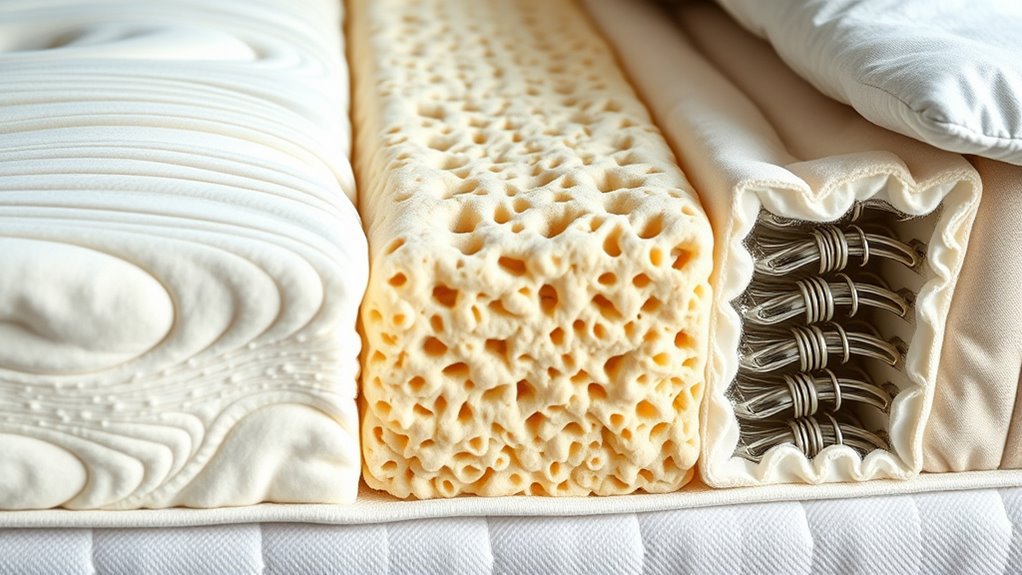
When choosing a latex mattress, you’ll want to contemplate the differences between natural and synthetic options, especially regarding environmental impact. Natural latex offers greater durability and responsiveness, making it a long-lasting, supportive choice, while synthetic latex is more affordable but less eco-friendly. If you’re concerned about allergies or chemical sensitivities, natural and organic latex mattresses provide a hypoallergenic sleep surface free from pesticides and synthetic additives. Additionally, AI-driven solutions are increasingly being used to develop more sustainable and environmentally friendly materials in mattress manufacturing. Incorporating certifications like GOLS or GOTS can help ensure the latex is produced sustainably and ethically, which is particularly important given the growing demand for vetted eco-friendly products. Understanding the environmental benefits of natural latex can help consumers make more informed, eco-conscious decisions when selecting a mattress. Exploring sustainable manufacturing processes can further enhance the eco-friendly appeal of natural latex options.
Natural vs. Synthetic Latex
Are you wondering how natural and synthetic latex mattresses compare? Natural latex is made from the sap of rubber trees, making it eco-friendly and often certified with labels like GOLS to guarantee organic sourcing. Synthetic latex, on the other hand, is petroleum-based, usually cheaper, but less durable and eco-conscious. Blended latex mixes both types, balancing affordability and sustainability. Here’s what you need to know:
- Natural latex is hypoallergenic and resistant to mold and dust mites. Sustainable harvesting methods Additionally, natural latex’s durability and comfort depend heavily on the harvesting and manufacturing processes used.
- Synthetic latex may emit higher levels of off-gassing and contain chemical preservatives.
- Blended latex offers a middle ground in durability and eco-friendliness.
- Natural latex’s sustainability depends on responsible harvesting and organic certification. Eco-friendly options Choosing natural latex supports eco-friendly practices, but synthetic options may appeal for budget or availability reasons.
Responsiveness and Longevity
Latex mattresses stand out for their exceptional responsiveness and durability, making them a popular choice for those seeking both comfort and long-term support. Their elasticity provides quick bounce and support, enhancing responsiveness to your movements. Natural latex, in particular, boasts a lifespan of 15 to 20 years, demonstrating its impressive longevity. The resilience of latex helps it maintain its shape and support over time, resisting sagging and indentations better than many foam options. This durability ensures consistent performance, even after years of use. Latex mattresses also offer excellent shape retention and sagging resistance, thanks to their resilient material. Whether natural or synthetic, latex’s elasticity and resilience make it a reliable, eco-friendly, and long-lasting choice for a supportive sleep surface. Additionally, advancements like continuous churn technology have further improved the manufacturing process, ensuring high-quality latex with consistent properties. These innovations contribute to the sustainability and overall quality of latex mattresses, making them an eco-conscious choice for environmentally aware consumers. Furthermore, the use of natural latex enhances the mattress’s eco-friendly profile, appealing to environmentally conscious buyers seeking sustainable sleep solutions. Moreover, latex’s responsiveness makes it especially suitable for those with varying sleep preferences or specific support needs. Properly maintained latex mattresses can also contribute to better airflow and temperature regulation, adding to their comfort and durability.
Eco-Friendly and Allergies
Natural latex mattresses appeal to eco-conscious shoppers because they’re made from rubber tree sap, a renewable resource harvested sustainably. These eco-friendly mattresses are ideal for allergy sufferers since natural latex is hypoallergenic and dust mite resistant. You can choose organic latex, which is GOLS-certified, ensuring environmentally responsible production. Keep in mind:
- Organic latex offers a chemical-free, sustainable option.
- Synthetic latex, though cheaper, often contains chemical additives and isn’t as eco-friendly.
- Blended latex combines natural and synthetic materials, balancing cost and eco-consciousness.
- Natural latex’s resilience makes it a durable choice for those seeking longevity and allergy relief.
Latex mattress types vary in composition and eco-friendliness, so understanding these differences can help you make an informed choice.
Choosing natural or organic latex helps you prioritize health and sustainability, while avoiding synthetic or blended options that may compromise eco-friendliness.
Comparing Support and Durability Across Materials
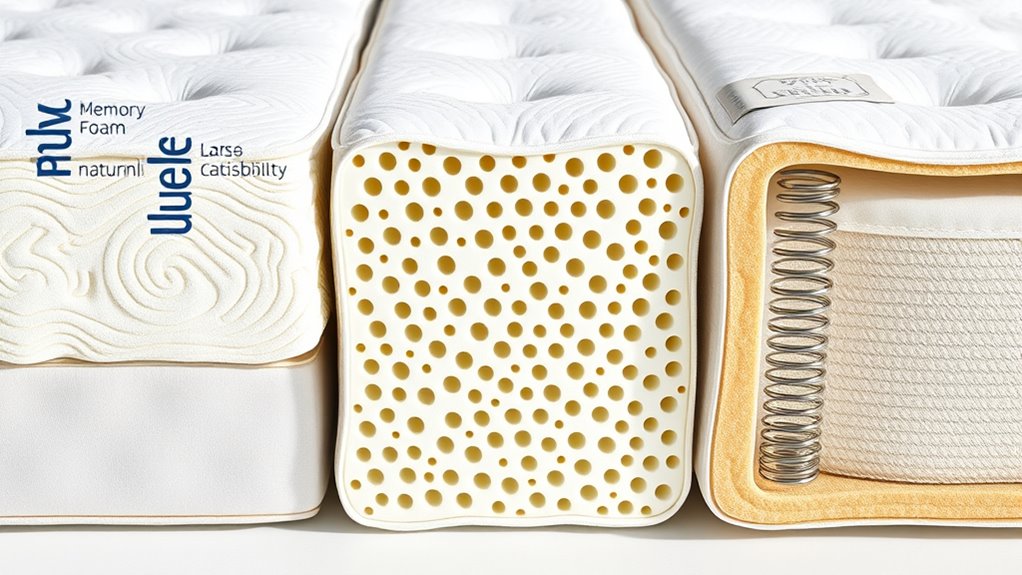
When comparing support and durability across mattress materials, it’s clear that each type offers distinct advantages. Memory foam provides excellent support that conforms closely to your body, but its lifespan is generally 10-20 years, depending on quality. Latex mattresses offer resilient support with a longer durability, often lasting 15-20 years, thanks to their resistance to sagging and indentation. Innerspring mattresses deliver firm support through steel coils, but their support quality can decline within 7-10 years as coils wear out. Higher-quality foam and latex tend to maintain their support and shape longer, enhancing overall lifespan. The durability of each material directly impacts resistance to sagging and indentation, influencing how well the mattress maintains its support over time.
Temperature Regulation and Heat Dissipation in Different Mattress Types
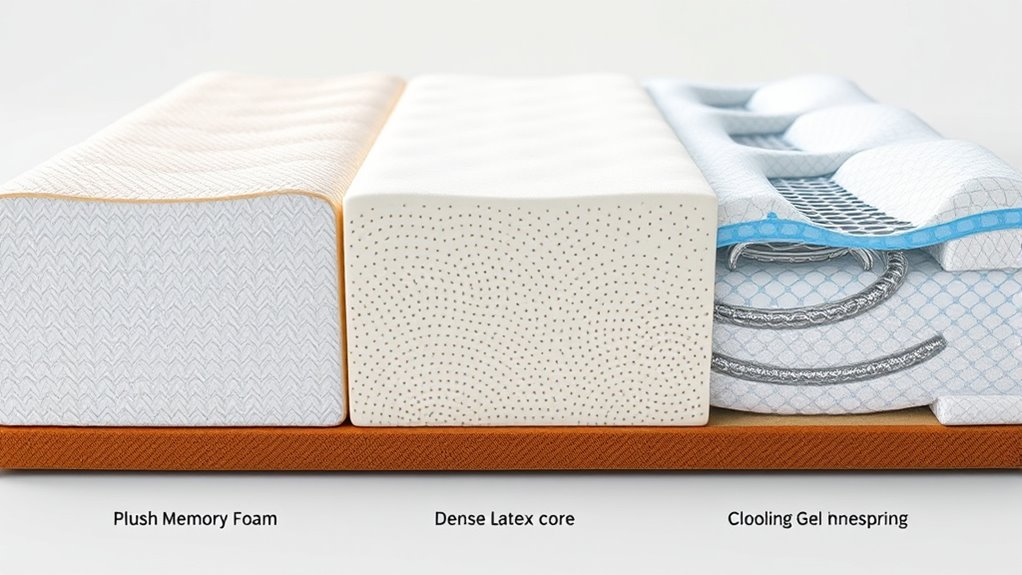
Choosing the right mattress for temperature regulation depends on how well it dissipates heat and keeps you cool throughout the night. Innerspring mattresses excel here due to their open coil designs that promote airflow, effectively dissipating heat. Latex mattresses are naturally breathable, with open-cell structures that enhance airflow and cooling. Memory foam, however, tends to trap heat because its dense foam layers insulate body heat, often requiring gel-infused foam with cooling gel particles to improve heat dissipation. Hybrid mattresses combine the airflow benefits of innerspring coils with foam or latex layers, offering a balanced approach.
- Innerspring mattresses provide superior airflow and heat dissipation.
- Latex mattresses’ open-cell structure promotes natural cooling.
- Gel-infused foam absorbs and disperses heat effectively.
- Foam layers in memory foam mattresses can retain heat without cooling enhancements.
Motion Isolation and Suitability for Couples

Memory foam mattresses are widely regarded for their excellent motion isolation, often reducing partner movement transfer by up to 80%. This makes them ideal for couples wanting undisturbed sleep, as their dense, conforming material absorbs motion and minimizes disturbance. Latex mattresses also offer good motion isolation, typically transferring less than 20% of movement, thanks to their resilience and support. In contrast, innerspring mattresses tend to have higher motion transfer, with coils transmitting up to 50% or more of partner movement, which can disrupt sleep.
| Mattress Type | Motion Transfer | Support & Pressure Relief | Allergen Resistance |
|---|---|---|---|
| Memory Foam | Low | Excellent | High |
| Latex | Low | Very Good | High |
| Innerspring | Moderate to High | Good | Moderate |
Cost Considerations and Longevity of Mattress Materials
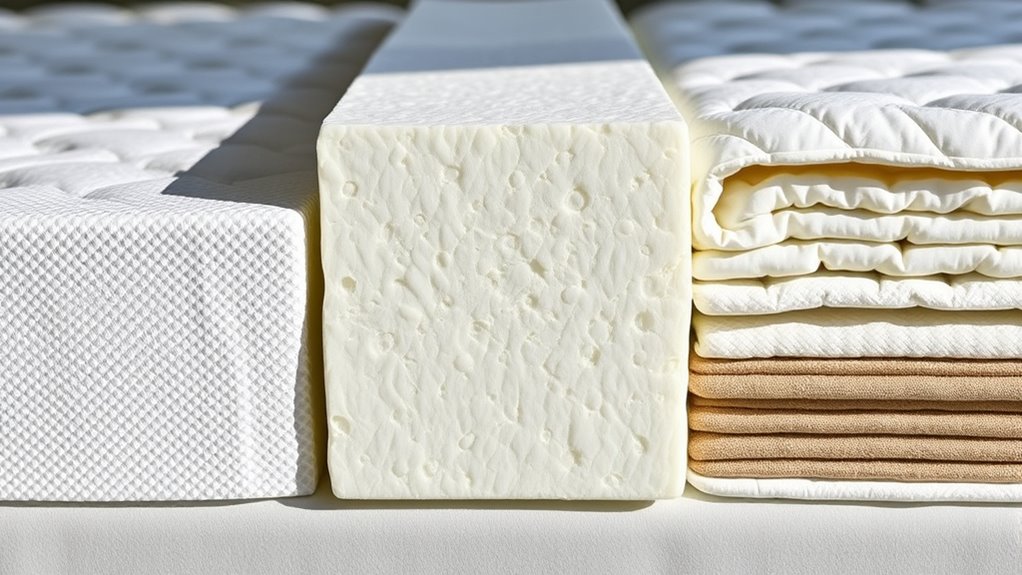
Understanding the cost and longevity of different mattress materials can help you make a smarter investment. Memory foam mattresses typically range from $500 to $2,500, with high-density foam and gel-infused options at the higher end. Latex mattresses are more expensive, often costing $1,000 to over $3,000, especially for organic latex varieties celebrated for their durability. Innerspring models are budget-friendly, starting as low as $100, but hybrid mattresses combine innerspring and foam for better longevity and comfort. Consider these factors:
Choosing durable, high-quality materials like latex or high-density foam can extend your mattress’s lifespan and save money long-term.
- Memory foam offers a lifespan of around 10-20 years, depending on quality.
- Latex mattresses, especially natural and organic latex, can last 15-20 years due to their durability.
- The overall mattress longevity depends on material quality and care.
- Investing in high-quality, durable materials can save you money long-term.
Frequently Asked Questions
Which Is Better Latex or Memory Foam or Spring Mattress?
When choosing between latex, memory foam, or a spring mattress, consider your comfort and needs. Latex offers lasting support, responsiveness, and durability, making it great if you want a resilient, natural option. Memory foam contours your body and reduces motion transfer, ideal for pressure relief and side sleepers. Spring mattresses are usually more affordable with better airflow, perfect if you prefer a bouncier feel and cooler sleep.
Why Are People No Longer Buying Memory Foam Mattresses?
People are passing on memory foam mattresses because they often trap heat, making you sweat and struggle to stay cool. You might notice chemical odors and off-gassing, which can be bothersome. Plus, the slow response to movement leaves you feeling stuck, and the higher price tag doesn’t always match the benefits. Instead, you’re favoring fresher, more breathable options like latex or spring mattresses that suit your sleep style better.
What Is the Best Material for Mattresses?
When choosing the best mattress material, it really comes down to your personal needs. If you want contouring support and minimal motion transfer, memory foam is great. For durability and breathability, latex works well, especially if you’re hot or have allergies. If you prefer traditional support and airflow, innerspring is suitable. Hybrid options blend features, giving you a balanced feel. Pick based on what matters most—support, temperature, durability, or budget.
Is an Innerspring Mattress Better Than a Memory Foam Mattress?
Have you ever wondered if an innerspring mattress is better than a memory foam one? It depends on what you prioritize. If you want better airflow, a bouncier, cooler feel, and more responsiveness, an innerspring might suit you better. But if you prefer contouring support, pressure relief, and less motion transfer, a memory foam mattress could be the right choice. Your personal preferences for support, temperature, and longevity matter most.
Conclusion
Choosing the right mattress material can totally transform your sleep experience—imagine waking up refreshed every single morning, feeling like you’ve just slept on a cloud made of magic! Whether you go for the classic bounce of innerspring, the plush hug of memory foam, or the eco-friendly comfort of latex, each offers its own superpower. Pick the one that suits you best, and get ready for nights so amazing, you’ll think you’ve entered a sleep utopia every single night!




